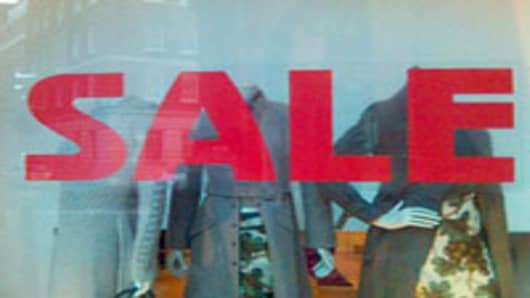It’s getting more difficult for discount-addicted consumers to get their fix. Major retailers are scaling back promotions — for better or worse.
While there’s no “Twelve Step” program to get consumers off the high of a great bargain, retailers are determined to hold the line. Some are showing signs of success even as consumer morale hit a six-month low on Friday.
One example is Guess — whose shares have bounced back since hitting a 52-week low on May 22.
Guess is seeing improved margins after cutting down on steep discounting, says Eric Beder, a retail analyst at Brean, Murray, Carret & Co. But, it wasn’t easy. At first, Guess saw a decline in the number of people coming to its stores and its same-store sales, a key sales metric that measures sales at stores open at least a year.
“You have to do it slowly," Beder says. "You have to offer a compelling product or it all falls apart again. It is a very painful process. If it’s done right, it has a much better and superior business model.”
The retailers who typically climb back to a full-price model are the ones with a unique lifestyle product, Beder says.
It’s a premise Rutgers School Of Business Marketing Professor Maureen Morrin studies. She conducts research on what drives consumers to make decisions.
“I think everyone loves to get a good bargain," Morrin says. "But, I think consumers have become a little immune to these discount claims.”
Consumers also may be skeptical, she says. "Is it really 70 percent off or did it start out at a very high price? They think ‘maybe I’m not really getting a bargain.’ It’s probably not as effective anymore.”
This is what Robin Lewis, a retail consultant and CEO of The Robin Report, calls "discount fatigue."
It’s a very real concept — one that JCPenneyhad hoped to capitalize on. The department store used a cold turkey approach in February. In an effort to turn its business around, JCPenney abruptly stopped its frequent salesand coupons in favor of an everyday low-pricing approach.
But, it did not boost sales. Since losing deal-hungry customers is no bargain, the company fired the man behind its market strategy, President Michael Francis, after less than a year on the job.
Lewis believes JCPenney’s pricing approach was a big faux pas because it came at the wrong time.
“It should have been the last leg after he reinvented the store into a unique experience,” says Lewis. “To wean a consumer off this kind of addictive behavior out there, it really requires product differentiation and a retail shopping experience. Retailers need things that add value or perceived value that the consumers are willing to pay full price for.”
Shrugging off out deep markdowns is a hard goal to achieve when JCPenney’s competitors such as Macy’s and Kohl’s are still offering frequent promotions. Combine that with the growing popularity of outlet stores, and sticking to your guns on pricing becomes much harder.
But, it can be done. Take Apple, for instance. It does not put its products on sale. Yet, shares are up more than 65 percent over the past 52 weeks.
“Retailers who survive will have to give consumers more value and that value is either in better products or with a unique and different experience,” says Lewis.
Pricing at that point comes back into some kind of reasonable perceived value, according to Lewis. And, that’s when those 70-percent off signs become virtually extinct.
Questions? Comments? Email us at consumernation@cnbc.com. Follow Stephanie Landsman on Twitter @StephLandsman



